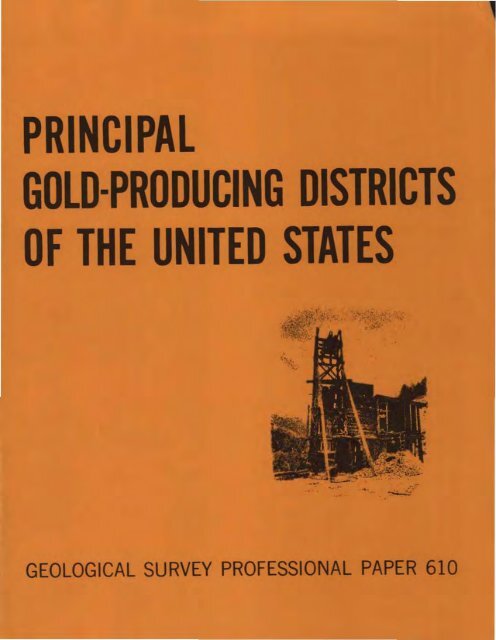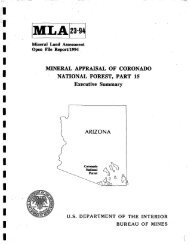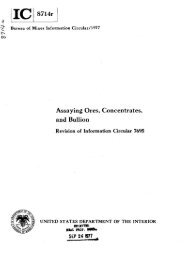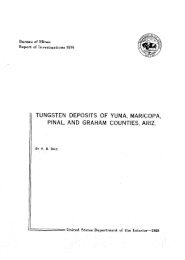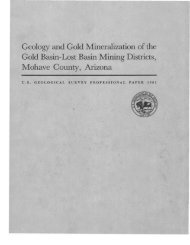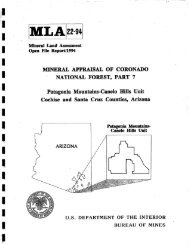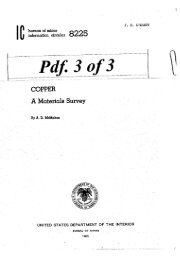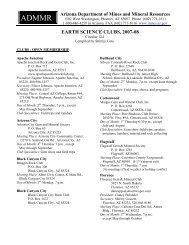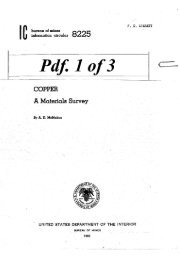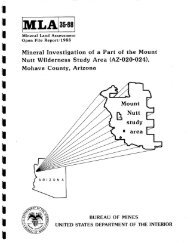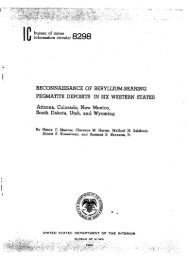here - State of Arizona Department of Mines and Mineral Resources
here - State of Arizona Department of Mines and Mineral Resources
here - State of Arizona Department of Mines and Mineral Resources
Create successful ePaper yourself
Turn your PDF publications into a flip-book with our unique Google optimized e-Paper software.
PRINCIPAL<br />
GOLD-PRODUCING D CIS<br />
OF THE UNITED S1 ES<br />
GEOLOGICAL SURVEY PROFESSIONAL PAPER 610
Principal<br />
Gold-Producing Districts<br />
<strong>of</strong> the United <strong>State</strong>s<br />
By A. H. KOSCHMANN <strong>and</strong> M. H. BERGENDAHL<br />
GEOLOGICAL SURVEY PROFESSIONAL PAPER 610<br />
A description <strong>of</strong> the geology, mining history,<br />
<strong>and</strong> production <strong>of</strong> the major gold-mining<br />
districts in21 <strong>State</strong>s<br />
UNITED STATES GOVERNMENT PRINTING OFFICE, WASHINGTON 1968
UNITED STATES DEPARTMENT OF THE INTERIOR<br />
JAMES G. WATT, Secretary<br />
GEOLOGICAL SURVEY<br />
Dallas L. Peck, Director<br />
Library <strong>of</strong> Congress Calalog-card No. GS 68-341<br />
First Printing 1968<br />
Second Printing 19SO<br />
Third Printing 1982<br />
For sale by the Superintendent <strong>of</strong> Documents. U.S. Government Printing Office<br />
Washington, D.C. 20402
Jlbstract _<br />
IntrodueQon _<br />
Scope <strong>and</strong> objecuves _<br />
Authorship <strong>and</strong> acknowledgments _<br />
Distribution <strong>of</strong> principal districts _<br />
Geologic relations _<br />
History <strong>of</strong> gold mining <strong>and</strong> trends in production_<br />
Jllabama _<br />
Cleburne County _<br />
Tallapoosa County _<br />
Jllaska _<br />
Cook Inlet-Susitna region _<br />
Copper River region _<br />
lCuskokwiro region _<br />
Northwestern Jllaska region _<br />
Seward Peninsula region _<br />
Southeastern Jllaska region -<br />
Southwestern Jllaska region _<br />
1{ukon region _<br />
Prince William Sound region _<br />
<strong>Arizona</strong> _<br />
Cochise County _<br />
Gila County _<br />
Greenlee County _<br />
!daricopa County _<br />
!dohave County _<br />
Pima County _<br />
Pinal County _<br />
Santa Cruz County _<br />
1{avapai County _<br />
1{uma County _<br />
California _<br />
Amador County _<br />
Butte County _<br />
Calaveras County _<br />
Del Norte County _<br />
EI Dorado County _<br />
Fresno County _<br />
Humboldt County _<br />
Imperial County _<br />
Inyo County _<br />
lCern County _<br />
Lassen County _<br />
Los Jlngeles County _<br />
Jdadera County _<br />
Jdariposa County _<br />
Jderced County _<br />
Jdodoc County _<br />
!dono County _<br />
Napa County _<br />
Nevada County _<br />
Placer County _<br />
Plumas County _<br />
Riverside County _<br />
Sacramento County _<br />
CONTENTS<br />
Pap California-Continued<br />
1 San Bernardino County _<br />
2 San Diego County _<br />
3 San Joaquin County _<br />
3 Shasta County _<br />
3 Sierra County _<br />
4 Siskiyou County _<br />
4 Stanislaus County _<br />
6 Trinity County _<br />
7 Tulare County _<br />
8 Tuolumne County _<br />
8 1:uba County _<br />
11 Colorado _<br />
13 Jldams County _<br />
14 Boulder County _<br />
16 Chaffee County _<br />
16 Clear Creek County _<br />
19 Custer County _<br />
23 Dolores County _<br />
23 Eagle County _<br />
31 Gilpin County _<br />
32 Gunnison County _<br />
35 Hinsdale County _<br />
37 Jefferson County _<br />
38 Lake COunty _<br />
39 La Plata County _<br />
40 lIineral County _<br />
42 Ouray County _<br />
43 Park County _<br />
odS Pitkin County _<br />
45 Rio Gr<strong>and</strong>e County _<br />
51 Routt County _<br />
53 Saguache County _<br />
58 San Juan County _<br />
58 San nligue1 County _<br />
59 Sunnnit County _<br />
60 Teller County _<br />
60 Georgia _<br />
61 Cherokee County _<br />
62 Lumpkin County _<br />
62 VVhite Count,y _<br />
62 Idaho _<br />
64 Jlda County _<br />
66 Bingham County _<br />
66 Blaine County _<br />
67 Boise County _<br />
67 Bonneville County _<br />
69 Camas County _<br />
69 Cassia, Jerome, <strong>and</strong> !dinidoka Counties _<br />
69 Clearwater County _<br />
70 Custer County _<br />
70 Elmore County _<br />
72 Gem County _<br />
73 Idaho County _<br />
74 Latah County _<br />
75 Lemhi County _<br />
III<br />
75<br />
76<br />
77<br />
77<br />
79<br />
80<br />
81<br />
81<br />
82<br />
82<br />
84<br />
84<br />
87<br />
87<br />
91<br />
93<br />
97<br />
98<br />
98<br />
99<br />
101<br />
102<br />
103<br />
11)3<br />
105<br />
106<br />
107<br />
109<br />
110<br />
111<br />
112<br />
112<br />
113<br />
114<br />
116<br />
117<br />
118<br />
119<br />
119<br />
]20<br />
]20<br />
]20<br />
]21<br />
]21<br />
]23<br />
126<br />
126<br />
126<br />
126<br />
127<br />
129<br />
130<br />
130<br />
133<br />
134
CONTENTS<br />
ILLUSTRATIONS<br />
FIGURES 1-4. Graphs showing:<br />
1. Gold production <strong>of</strong> the United <strong>State</strong>s-1799 through 1965 4<br />
2. Gold production (to nearest 1,000 ounces) <strong>of</strong> 25 principal gold-mining districts<br />
<strong>of</strong> the United <strong>State</strong>s-through 1959___________________________ 5<br />
3. Annual gold production <strong>of</strong> Alabama, Gorgia, North Carolina, South Carolina,<br />
<strong>and</strong> Virginia, 1823-1960 7<br />
4. Annual gold production <strong>of</strong> Alaska, 1880-1965 9<br />
5. Map showing gold-mining districts <strong>of</strong> Alaska 10<br />
6. Graph showing annual gold production <strong>of</strong> <strong>Arizona</strong>, 1881-1965 33<br />
7. Map showing gold-mining districts <strong>of</strong> <strong>Arizona</strong> 34<br />
8. Graph showing annual gold production <strong>of</strong> California, 1848-1965 54<br />
9. Map showing gold-mining districts <strong>of</strong> California 56<br />
10. Map showing gold-mining districts <strong>of</strong> Colorado 85<br />
11. Graph showing annual gold production <strong>of</strong> Colorado, 1868-1965 87<br />
12. Map showing gold-mining districts <strong>of</strong> Idaho 122<br />
13. Graph showing annual gold production <strong>of</strong> Idaho, 1880-1965 124<br />
14. Map showing gold-mining districts <strong>of</strong> Montana 142<br />
15. Graph showing annual gold production <strong>of</strong> Montana, 1900-65 143<br />
16. Map showing gold-mining districts <strong>of</strong> Nevada 172<br />
17. Graph showing annual gold production <strong>of</strong> Nevada, 1880-1966 174<br />
18. Graph showing annual gold production <strong>of</strong> New Mexico, 1881-1965 201<br />
19-21. Maps showing:<br />
19. Gold-mining districts <strong>of</strong> New Mexico 203<br />
20. Gold-mining localities <strong>of</strong> North Carolina 212<br />
21. Gold-mining districts <strong>of</strong> Oregon 217<br />
22. Graph showing annual gold production <strong>of</strong> Oregon, 1881-1965 218<br />
23. Map showing gold-mining districts <strong>of</strong> South Dakota 233<br />
24. Graph showing annual gold production <strong>of</strong> South Dakota, 1876-1965 234<br />
25. Map showing gOld-mining districts <strong>of</strong> Utah 241<br />
26. Graph showing annual gold production <strong>of</strong> Utah, 1866-1965 242<br />
27. Graph showing annual gold production <strong>of</strong> Washington, 1881-1965 255<br />
28. Map showing gold-mining districts <strong>of</strong> Washington 256<br />
v
o<br />
Mother Lode. East Belt <strong>and</strong> West Belt, Calaveras County, Calif. (2,046,000)<br />
Alleghany <strong>and</strong> Downieville, Calif. (2,173,000)<br />
Bisbee, Ariz. (2,193,000)<br />
Boise Basin, Idaho (2,300,000)<br />
Virginia City. Mont. (2,617.000)<br />
Tintic, Utah (2,648.000)<br />
Butte. Mont. (2.725,000)<br />
Tertiary placers. Nevada County. Calif. (2,903,000)<br />
La Porte, Calif. (2,910,000)<br />
Leadville. Colo. (2,970.000)<br />
Folsom. Calif. (3,000,000)<br />
Telluride. Colo. (3,000,000)<br />
Nome, Alaska (3,606.000)<br />
Goldfield, Nev. (4,195.000)<br />
Central City. Colo. (4.200.000)<br />
Hammonton, Calif. (4,387.000)<br />
Columbia Basin. Calif. (5,874,000)<br />
Juneau, Alaska (6.884.000)<br />
Fairbanks. Alaska (7,464.000)<br />
20 40<br />
100 120 140 160 180<br />
MILLIONS OF FINE OUNCES<br />
INTRODUCTION 5<br />
FIGURE 2.-Gold production (to nearest 1,000 ounces) <strong>of</strong> 25 principal gold-mining districts <strong>of</strong> the United <strong>State</strong>sthrough<br />
1959.<br />
mining activity boomed; gold production reached<br />
2 million ounces in 1850 <strong>and</strong> 3 million ounces in<br />
1853. It then declined steadily <strong>and</strong> in 1862 again<br />
dropped below the 2-million-ounce level. Placers<br />
were the chief source <strong>of</strong> our domestic output until<br />
1873 (Loughlin <strong>and</strong> others, 1930, fig. 3), when their<br />
output was exceeded by that <strong>of</strong> lode mines, a relation<br />
that has continued through 1965. Placer activity<br />
remained at a relatively low ebb during the<br />
1880's <strong>and</strong> early 1890's, but t<strong>here</strong> were three periods<br />
in later years when placer production, though exceeded<br />
by lode production, formed a significant proportion<br />
<strong>of</strong> the domestic output-in 1896 when large<br />
dredges were introduced in California, in 1904<br />
when large deposits <strong>of</strong> rich gravels were discovered<br />
in Alaska, <strong>and</strong> in 1934 when the price <strong>of</strong> gold was<br />
increased to $35 an ounce.<br />
In many districts the prospectors followed goldbearing<br />
gravel to the source <strong>of</strong> the gold in veins,<br />
200<br />
<strong>and</strong> lode mining began shortly after placer mining.<br />
It was not, however, until about the middle 1860's,<br />
when the Mother Lode <strong>and</strong> Grass Valley lodes in<br />
California <strong>and</strong> the Comstock Lode in Nevada became<br />
important producers, that lode mines became<br />
significant sources <strong>of</strong> gold. Lode production increased<br />
rapidly after the discovery <strong>of</strong> gold in the<br />
Cripple Creek district, Colorado, in 1892. By 18':\8,<br />
production from this district together with the increased<br />
placer production in California <strong>and</strong> the accelerated<br />
output <strong>of</strong> the Homestake mine at Le"d,<br />
S. Dak., had raised our annual gold production to<br />
more than 3 million ounces. Production continned<br />
to rise with the discoveries <strong>of</strong> gold at Tonop"h,<br />
Nev., in 1903, the placer deposits <strong>of</strong> Alaska in 1914,<br />
<strong>and</strong> gold at Goldfield, Nev., in 1905. By 1905 g1ld<br />
production for the first time exceeded 4 million<br />
ounces, a level maintained until 1917. Because o:l' a<br />
shortage <strong>of</strong> manpower during World War I, pro-
34 PRINCIPAL GOLD-PRODUCING DISTRICTS OP THE UNITED STATES<br />
o I<br />
114"<br />
50<br />
I<br />
100 MILES<br />
!<br />
FIGURE '1.-Gold-mining districts <strong>of</strong> <strong>Arizona</strong>.
56 PRINCIPAL GOLD-PRODUCING DISTRICTS OF THE UNITED STATES<br />
42'<br />
41·<br />
40'<br />
39'<br />
124'<br />
38'<br />
Fm1Ja 9.-Gold-miniDg districts <strong>of</strong> California.<br />
o<br />
I<br />
50<br />
I<br />
100 MILES<br />
! I<br />
, ,<br />
"
COVE DISTRICT<br />
The Cove district is 45 miles northeast <strong>of</strong> Bakersfield<br />
near Kernville, in T. 25 S., R. 33 E.<br />
In the late 1850's a few placers were worked in<br />
the Cove district by the more persistent <strong>of</strong> the<br />
prospectors drawn to the area by the original discoveries<br />
in Kern County, along the Kern River, in<br />
1851. Gold-bearing quartz veins were found in 1860.<br />
The towns <strong>of</strong> Quartzburg <strong>and</strong> Kernville, which were<br />
founded in the boom that followed, experienced a<br />
period <strong>of</strong> orderly growth <strong>and</strong> prosperity. The Big<br />
Blue mine <strong>of</strong> Kern <strong>Mines</strong>, Inc., was discovered early<br />
in the history <strong>of</strong> the district. The mine became the<br />
major producer <strong>and</strong> was credited with $1,746,910<br />
in gold to 1933 (Tucker <strong>and</strong> others, 1949, p. 211) ;<br />
most <strong>of</strong> this production was in the first few years<br />
<strong>of</strong> the mine's activity. In 1883 most <strong>of</strong> the workings<br />
were destroyed by fire, <strong>and</strong> the mine was inactive<br />
until 1907 when the first <strong>of</strong> several unsuccessful<br />
attempts was made to rehabilitate the property.<br />
Total gold production <strong>of</strong> the district through 1959<br />
was about 262,800 ounces; none had been reported<br />
since 1942.<br />
The country rock consists <strong>of</strong> metasedimentsphyllites,<br />
quartzites, <strong>and</strong> limestone <strong>of</strong> the Kernville<br />
Series <strong>of</strong> Carboniferous (1) age, <strong>and</strong> the Isabella<br />
Granodiorite <strong>and</strong> acidic dikes <strong>of</strong> Jurassic(?) age.<br />
The granodiorite is probably related to the main<br />
Sierra Nevada batholith (Prout, 1940, p. 385-389;<br />
Miller <strong>and</strong> Webb, 1940, p. 378).<br />
The metamorphic rocks are intensely deformed<br />
<strong>and</strong> crumpled by the intrusive rock. Along the east<br />
edge <strong>of</strong> the Cove district is the north-trending Kern<br />
Canyon fault, the major structure in the area.<br />
Ore deposits consist <strong>of</strong> veins which seem to be<br />
related to the closing stages <strong>of</strong> igneous activity. The<br />
veins occur in shear zones, parallel to the Kern<br />
Canyon fault, <strong>and</strong> are associated with acidic dikes<br />
that cut the granodiorite <strong>and</strong> metasediments (Prout,<br />
1940, p. 386, 391-392). The veins are dominantly<br />
quartz with small amounts <strong>of</strong> calcite. The ore minerals<br />
are gold, which occurs in the free state, arsenopyrite,<br />
galena, <strong>and</strong> sphalerite (Prout, 1940,<br />
p. 411-412).<br />
GREEN MOUNTAIN DISTRICT<br />
The Green Mountain district includes the area<br />
between Piute, on the west slope <strong>of</strong> the Piute Mountains,<br />
<strong>and</strong> the edge <strong>of</strong> Kelsey Valley, on the east side<br />
<strong>of</strong> the Piute Mountains.<br />
Gold production <strong>of</strong> this district through 1959 was<br />
about 33,100 ounces. The Bright Star mine was the<br />
major producer, with an estimated $600,000 total<br />
output (Tucker <strong>and</strong> Sampson, 1933, p. 280).<br />
CALIFORNIA 65<br />
Bedrock in the area consists <strong>of</strong> metasedimentary<br />
rocks <strong>of</strong> the Kernville Series <strong>of</strong> Carboniferous (1)<br />
age <strong>and</strong> Isabella Granodiorite <strong>of</strong> Jurassic (1) age<br />
(Miller <strong>and</strong> Webb, 1940, p. 349-358). The metasedimentary<br />
rocks occur in northwest-trending b<strong>and</strong>s<br />
<strong>and</strong> include marble, phyllite, mica schist, <strong>and</strong><br />
quartzite. The gold deposits are in small, but rich,<br />
shoots in narrow quartz veins.<br />
KEYES DISTRIOV<br />
The Keyes district, 35 miles north <strong>of</strong> Calientp. in<br />
T. 26 S., Rs. 32 <strong>and</strong> 33 E., produced about 3S,600<br />
ounces <strong>of</strong> gold through 1959, all from lodes.<br />
Detailed accounts <strong>of</strong> the history <strong>and</strong> geolog:'T <strong>of</strong><br />
this district were not found; however, Tucker <strong>and</strong><br />
Sampson (1933, p. 283) reported that the deposits<br />
in the district are in narrow high-grade vein" in<br />
granite.<br />
RAND DISTRICT<br />
The R<strong>and</strong> district is on the San Bernardino-Yern<br />
County line. R<strong>and</strong>sburg, 45 miles northeast <strong>of</strong><br />
Mojave, is in the center <strong>of</strong> the district. Althc'lgh<br />
more than half the area is in San Bernardino<br />
County, nearly all the gold mined in the district<br />
has come from the western part, in Kern County.<br />
This is the most important district in Kern County,<br />
<strong>and</strong> it contains the largest gold mine in the county,<br />
the Yellow Aster. Gold has been the chief r'lmmodity<br />
mined; silver has been a byproduct.<br />
Placer gold was discovered in the winter <strong>of</strong> U'q3<br />
94 at Goler Wash, 9 miles northwest <strong>of</strong> R<strong>and</strong>sb'lrg,<br />
<strong>and</strong> by 1895 the lode deposits <strong>of</strong> the Yellow Aster<br />
mine were developed (Hess, 1910, p. 31-32). Of the<br />
estimated $9 to $10 million worth <strong>of</strong> ore mined<br />
before 1910, the Yellow Aster produced $6 miJIion<br />
(Hess, 1910, p. 32).<br />
Tucker <strong>and</strong> Sampson (1933, p. 285-286) ("ave<br />
estimates <strong>of</strong> the production <strong>and</strong> a brief account <strong>of</strong><br />
the geology. Gold production through 1959 was<br />
836,300 ounces, all but about 1,700 ounces was<br />
from lode mines.<br />
The country rock in the gold-producing par <strong>of</strong><br />
the district consists <strong>of</strong> the R<strong>and</strong> Schist <strong>and</strong> the<br />
Atolia Quartz Monzonite which intruded the scl'ist.<br />
Numerous rhyolite pipes, dikes, <strong>and</strong> sills <strong>of</strong> late<br />
Miocene age are found locally. Gold ores occur in<br />
fissure veins <strong>and</strong> as impregnations <strong>and</strong> stockworks<br />
in both the monzonite <strong>and</strong> R<strong>and</strong> schist. The<br />
strongest veins have been found to be in two systems-one<br />
strikes N. 80° E. <strong>and</strong> the other, northwest.<br />
The principal vein minerals are quartz, arsenopyrite,<br />
pyrite, galena, gold, scheelite, iron
68 PRINCIPAL GOLD-PRODUCING DISTRICTS OF THE UNITED STATES<br />
Gold production <strong>of</strong> Mariposa County for 1880<br />
1959 was about 2,144,500 ounces: about 583,500<br />
ounces came from placers <strong>and</strong> about 1,561,000<br />
ounces came from lodes. Production before 1880 has<br />
not been determined.<br />
Gold mining began at an early date in the county.<br />
Gravels along Agua Fria <strong>and</strong> Mariposa Creeks<br />
were worked before 1849 <strong>and</strong> were thoroughly<br />
mined out by the hordes <strong>of</strong> prospectors who overran<br />
the area during the gold rush <strong>of</strong> 1849. By July<br />
1849 a stamp mill was processing ore from the first<br />
lode discovery in the county, the Mariposa mine on<br />
the Mother Lode (Bowen <strong>and</strong> Gray, 1957, p. 39, 43).<br />
Lode mining in Mariposa County was inhibited<br />
by the controversial Las Mariposas l<strong>and</strong> grant<br />
which gave title to 14 <strong>of</strong> the 24 miles <strong>of</strong> the Mother<br />
Lode in the county to Gen. John C. Fremont. This<br />
grant was unsurveyed <strong>and</strong> was made before gold<br />
was discovered. Long before Fremont attempted to<br />
establish his right, the grant was overrun with<br />
prospectors <strong>and</strong> miners, who underst<strong>and</strong>ably were<br />
reluctant to give up what they considered just<br />
claims. Mter years <strong>of</strong> conflict in <strong>and</strong> out <strong>of</strong> the<br />
courts, Fremont's claim to the grant was formally<br />
recognized. But by then the property was plagued<br />
by mismanagement <strong>and</strong> inefficiency <strong>and</strong> the mines<br />
never fulfilled the expectations <strong>of</strong> the authorities<br />
who evaluated them (Julihn <strong>and</strong> Horton, 1940, p.<br />
95-96).<br />
Another large estate, the Cook estate, which encompassed<br />
most <strong>of</strong> the mines along a 2-mile length<br />
<strong>of</strong> the Mother Lode in the Coulterville area, further<br />
complicated operations on the Mother Lode in Mariposa<br />
County (Julihn <strong>and</strong> Horton, 1940, p. 96-97).<br />
Despite the early frustrations, lode mining in<br />
Mariposa County flourished <strong>and</strong> was especially successful<br />
in the late 1930's <strong>and</strong> early 1940's before<br />
most <strong>of</strong> the mines closed in compliance with War<br />
Production Board Order L-208 issued in October<br />
1942. After World War II gold mining declined,<br />
<strong>and</strong> during 1950-59 the average annual gold output<br />
was less than 1,000 ounces.<br />
The western two-thirds <strong>of</strong> the county is underlain<br />
by metasedimentary rocks <strong>and</strong> metavolcanics<br />
<strong>of</strong> Paleozoic <strong>and</strong> Late Jurassic age, <strong>and</strong> the eastern<br />
one-third is underlain chiefly by intrusives <strong>of</strong> Late<br />
Jurassic or Early Cretaceous age (Bowen <strong>and</strong> Gray,<br />
1957, p. 45). The intrusive rocks consist <strong>of</strong> various<br />
types <strong>of</strong> granitic <strong>and</strong> peridotitic rocks, but biotitehornblende<br />
granodiorite is predominant.<br />
HORNITOS DISTRICT<br />
The Hornitos district, in western Mariposa<br />
County at lat 37°30' N. <strong>and</strong> long 120°14' W., is<br />
noted for gold production from both plac"rs <strong>and</strong><br />
lodes.<br />
In the early days the Quaternary grr.vels <strong>of</strong><br />
Hornitos Creek yielded considerable gold, b'1t these<br />
were nearly exhausted before 1900. The lode mines<br />
are all west <strong>of</strong> the Mother Lode, in the zone <strong>of</strong> veins<br />
referred to as the West Belt. Total production from<br />
the district is not known, but a minimum <strong>of</strong> 500,000<br />
ounces seems to be a reasonable estimate.<br />
The gold deposits <strong>of</strong> the West Belt are in veins<br />
that cut several rock types, chiefly metasedimentary<br />
rocks <strong>of</strong> the Mariposa Formation <strong>of</strong> Jurar"lic age.<br />
The Mariposa is intruded locally by serpentinized<br />
peridotite, pyroxenite, basic intrusives altered to<br />
hornblende schists, <strong>and</strong> acid intrusives such as<br />
granite <strong>and</strong> granodiorite (Julihn <strong>and</strong> Hort(J"l, 1940,<br />
p. 116-117). Most <strong>of</strong> the gold deposits al'';! along<br />
contacts <strong>of</strong> igneous rocks <strong>and</strong> metasedimentary<br />
rocks.<br />
MERCED RIVER PLACERS<br />
Quaternary gravels along the Merced River west<br />
<strong>of</strong> Bagby were a source <strong>of</strong> placer gold in the late<br />
1860's <strong>and</strong> 1870's (Bowen <strong>and</strong> Gray, 1957, p. 187),<br />
but little activity has been reported in recert years.<br />
Production from these deposits is not known, but<br />
probably was at least 50,000 ounces <strong>of</strong> gold.<br />
MORMON BA.R DISTRICT<br />
The Mormon Bar district is in T. 5 S., r.. 18 E.,<br />
about 2lh miles south <strong>of</strong> the town <strong>of</strong> Mariposa.<br />
In the early days <strong>of</strong> mining in Mariposa County,<br />
the headwaters <strong>of</strong> Mariposa Creek near Mormon<br />
Bar was the scene <strong>of</strong> considerable placer activity.<br />
By 1870, however, the deposits, which were only<br />
about 6 feet thick, were almost worked out, <strong>and</strong><br />
t<strong>here</strong>after the placer output <strong>of</strong> the entire county<br />
averaged only a few hundred ounces p"r year<br />
(Julihn <strong>and</strong> Horton, 1940, p. 159, 162). In the late<br />
1930's a slight revival took place, <strong>and</strong> the gravels<br />
at Mormon Bar were worked industriously by dragline<br />
(Julihn <strong>and</strong> Horton, 1940, p. 159). Total gold<br />
production for the district is estimated r.t about<br />
75,000 ounces.<br />
MOTHER LODE A.ND EAST BELT DISTRI0TS<br />
The Mother Lode, which has its southen terminus<br />
in Mariposa County, is a northwest-t.rending<br />
zone that is 3 or 4 miles wide <strong>and</strong> extends from the<br />
town <strong>of</strong> Mormon Bar northward through Coulterville<br />
into Tuolumne County. Roughly parallel veins<br />
east <strong>of</strong> this zone are referred to as the East. Belt.<br />
Though much has been said about the pr....duction<br />
<strong>of</strong> the Mother Lode, the mines <strong>of</strong> the East Belt <strong>and</strong>
70 PRINCIPAL GOLD-PRODUCING DISTRICTS OF THE UNITED STATES<br />
lite tuff <strong>of</strong> Tertiary <strong>and</strong> Quaternary age. Granitic NEVADA COUNTY<br />
stocks <strong>of</strong> Cretaceous (?) age form the White Moun- The gold-quartz mines <strong>of</strong> the Grass ,.,alleytains,<br />
at the southeast boundary <strong>of</strong> the county, <strong>and</strong> Nevada City district in Nevada County have been<br />
Blind Springs Hill, east <strong>of</strong> Benton. the most productive in the <strong>State</strong>, <strong>and</strong> the Empire<br />
BODIE DISTRICT<br />
The Bodie district is in northeast Mono County,<br />
in T. 4 N., R. 27 E. Mining was started in 1860,<br />
<strong>and</strong> the district was active until 1955. Total gold<br />
production was 1,456,300 ounces, most <strong>of</strong> which<br />
came from the St<strong>and</strong>ard mine.<br />
Country rock in the district consists <strong>of</strong> a "complex<br />
<strong>of</strong> igneous rocks <strong>and</strong> breccias" overlain (perhaps<br />
along a fault) by Tertiary hornblende <strong>and</strong>esite<br />
(Brown, 1908, p. 343-344). Ore bodies occur in<br />
three sets <strong>of</strong> auriferous quartz veins in the <strong>and</strong>esite<br />
(Brown, 1908,p.345-346).<br />
MASONIC DISTRICT<br />
The Masonic district is in northeast Mono<br />
County, in T. 6 N., R. 26 E. Gold occurs in quartz<br />
veins in metamorphic rocks <strong>and</strong> granite. The Pittsburg-Liberty<br />
mine, with a record <strong>of</strong> $470,000 in<br />
gold (about 34,000 ounces), has been the important<br />
producer (Sampson <strong>and</strong> Tucker, 1940, p. 121). The<br />
district was active on a small scale in 1959. No detailed<br />
descriptions <strong>of</strong> the geology were found.<br />
NAPA COUNTY<br />
Total recorded gold production for Napa County<br />
is 23,225 ounces, all from the Calistoga district in<br />
the northwest corner <strong>of</strong> the county. The first gold<br />
production recorded was in 1875 when $93,000 in<br />
combined gold <strong>and</strong> silver was listed (Davis, 1948,<br />
p. 165). Intermittent production continued to 1941.<br />
Gold has been a byproduct from the Palisade <strong>and</strong><br />
Silverado silver mines (Davis, 1948, p. 183). No<br />
other information on this district could be found.<br />
Along the eastern border <strong>of</strong> the county is a<br />
4-mile-wide belt <strong>of</strong> folded siltstones, s<strong>and</strong>stones,<br />
<strong>and</strong> a few limestones composing the Shasta Series,<br />
<strong>of</strong> Cretaceous age (Davis, 1948, p. 162). These<br />
rocks are flanked on the west by a 1Y2-mile-wide<br />
strip <strong>of</strong> the Jurassic Knoxville Formation, which is<br />
the lower, conglomeratic unit <strong>of</strong> the Shasta Series<br />
(Weaver, 1949, p. 21-22). The remainder <strong>of</strong> the<br />
northern half <strong>of</strong> the county is underlain by metamorphic<br />
<strong>and</strong> cherty sedimentary rocks <strong>and</strong> associated<br />
basic intrusive rocks <strong>of</strong> the Franciscan Group,<br />
<strong>of</strong> Jurassic age. In the western part <strong>of</strong> the county,<br />
the east side <strong>of</strong> the Napa Valley is covered by a<br />
thick section <strong>of</strong> Pliocene volcanic rocks, <strong>and</strong> on the<br />
west side <strong>of</strong> the valley, the Shasta Series is overlain<br />
locally by Pliocene volcanic rocks.<br />
mine in the same district was in continuous operation<br />
from 1850 to 1940, which at that time was the<br />
longest period <strong>of</strong> operation for any gold mine in<br />
the country (Logan, 1941, p. 375). Placer production<br />
has also been significant, especially in the early<br />
days; however, no consistent records have been<br />
kept. Tertiary gravels on San Juan Ridge, North<br />
Columbia, Sailor Flat, Blue Tent, Scotts Flat,<br />
Quaker Hill, <strong>and</strong> Red Dog-You Bet still c'lntain<br />
tremendous reserves, but these are for the most<br />
part undeveloped because <strong>of</strong> the curtailment <strong>of</strong> hydraulic<br />
mining.<br />
The total gold production <strong>of</strong> the county from<br />
1849 through 1959 was 17,016,000 ounces, including<br />
Lindgren's (1896, p. 26) estimate <strong>of</strong> $133,800,000<br />
in gold. Since 1903, when placer <strong>and</strong> lode production<br />
have been reported separately by the U.f', Geological<br />
Survey (1904-24) <strong>and</strong> U.S. Bureau <strong>of</strong> <strong>Mines</strong><br />
(1925-34, 1933-66), 286,655 ounces <strong>of</strong> placer <strong>and</strong><br />
7,119,353 ounces <strong>of</strong> lode gold have been mined in<br />
the county.<br />
GRASS VALLEY·NEVADA CITY DISTRICT<br />
Because the towns <strong>of</strong> Grass Valley <strong>and</strong> loTevada<br />
City, which form the center <strong>of</strong> the Grass '-'alley<br />
Nevada City district, are only 4 miles apart <strong>and</strong><br />
because <strong>of</strong> their similarity in geology, distribution<br />
<strong>and</strong> mineralogy <strong>of</strong> veins, <strong>and</strong> common history <strong>and</strong><br />
development, they are discussed together.<br />
The initial rush to this area took place in 1850<br />
after rich gravels were discovered near the r··esent<br />
site <strong>of</strong> Nevada City. In October <strong>of</strong> the same year.<br />
the first lode discovery was made at Gold Ifill on<br />
the outskirts <strong>of</strong> Grass Valley (Johnston, 1940,<br />
p. 19). Almost immediately the towns <strong>of</strong> Grass<br />
Valley <strong>and</strong> Nevada City were founded; ther grew<br />
rapidly, prospered, <strong>and</strong> became permanent communities.<br />
By 1851 quartz mines had been developed at<br />
Nevada City, but these early ventures failed. The<br />
miners turned to working the rich Tertiary rravels<br />
on a large scale by introducing hydraulic methods<br />
(Lindgren, 1896, p. 19). The discovery at Gold Hill<br />
was followed by discoveries <strong>of</strong> veins at Ophir Hill,<br />
Rich Hill, <strong>and</strong> Massachusetts Hill, <strong>and</strong> by 1867<br />
most <strong>of</strong> the major mines <strong>of</strong> the district had been<br />
located. Grass Valley, w<strong>here</strong> 1,600 men were working<br />
<strong>and</strong> 284 stamps were crushing the ore, WNl then<br />
one <strong>of</strong> the leading camps in California (Jol'nston,
Adams County:<br />
I, Clear Creek placers.<br />
Boulder County:<br />
2, Jamestown; 3, Gold Hill-Sugarloaf;<br />
4, Ward; 5, Magnolia; 6,<br />
Gr<strong>and</strong> Isl<strong>and</strong>-Caribou.<br />
Chaffee County:<br />
7, Chalk Creek; 8, Monarch.<br />
Clear Creek County:<br />
9, Alice; 10, Empire; 11, Idaho<br />
Springs; 12, Freel<strong>and</strong>-Lamartine;<br />
13, Georgetown-Silver Plume; 14,<br />
Argentine.<br />
Custer County:<br />
15, Rosita Hills.<br />
Dolores County:<br />
16, Rico.<br />
Eagle County:<br />
17, Gilman.<br />
o I<br />
COLORADO 85<br />
50<br />
I<br />
100 MILES<br />
I<br />
FIGURE 10.-Gold-mining districts <strong>of</strong> Colorado.<br />
Gilpin County:<br />
18, Northern Gilpin; 19, Central<br />
City.<br />
Gunnison County:<br />
20, Gold Brick-Quartz Creek; 21,<br />
Tincup.<br />
Hinsdale County:<br />
22, Lake City.<br />
Jefferson County:<br />
23, Clear Creek placers.<br />
Lake County:<br />
24, Leadville; 25, Arkansas River<br />
valley placers.<br />
La Plata County:<br />
26, La Plata.<br />
<strong>Mineral</strong> County:<br />
27, Creede.<br />
Ouray County:<br />
28, Sneffels-Red Mountain; 29,<br />
Uncompahgre.<br />
Park County:<br />
30, Alma; 31, Fairplay; 82, T-nyall.<br />
Pitkin County:<br />
33, Independence Pass.<br />
Rio Gr<strong>and</strong>e County:<br />
34, Summitville.<br />
Routt County:<br />
35, Hahns Peak.<br />
Saguache County:<br />
36, Bonanza.<br />
San Juan County:<br />
37, Animas; 38, Eureka.<br />
San Miguel County:<br />
39, Ophir; 40, Telluride; 41,<br />
Mount Wilson.<br />
Summit County:<br />
42, Breckenridge; 48, Tenmile.<br />
Teller County:<br />
44, Cripple Creek.
GILMAN DISTRICT<br />
The Gilman (Battle Mountain, Red Cliff) district,<br />
in southeastern Eagle County on the northeast<br />
flank <strong>of</strong> the Sawatch Range, is between Gilman <strong>and</strong><br />
Red Cliff, about 20 miles north <strong>of</strong> Leadville. Gold<br />
has been extracted from pyritic gold ores <strong>and</strong> as a<br />
byproduct <strong>of</strong> base-metal ores.<br />
The initial discovery in 1879 <strong>of</strong> silver-lead ore in<br />
limestone was followed in 1884 by finds <strong>of</strong> gold ore<br />
in the underlying quartzite. The relative importance<br />
<strong>of</strong> the metals mined varied periodically in the history<br />
<strong>of</strong> the district. Before 1905 silver <strong>and</strong> gold<br />
were the major commodities, w<strong>here</strong>as lead <strong>and</strong> copper<br />
were <strong>of</strong> minor importance. From 1905 to 1930<br />
zinc was the principal product <strong>and</strong> from 1931 to<br />
1941 silver-copper ore containing considerable gold<br />
was mined. Zinc again regained importance from<br />
1942 through 1959. The total gold production <strong>of</strong> the<br />
district through 1959 was roughly 348,000 ounces.<br />
Precambrian granite, schist, <strong>and</strong> gneissic diorite<br />
are exposed in the bottom <strong>of</strong> Eagle Canyon <strong>and</strong> are<br />
overlain by thin lower Paleozoic formations that<br />
include the Sawatch Quartzite <strong>of</strong> Cambrian age, the<br />
Harding S<strong>and</strong>stone <strong>of</strong> Ordovician age, the Chaffee<br />
Formation <strong>of</strong> Devonian age, <strong>and</strong> the Leadville Limestone<br />
<strong>of</strong> Mississippian age. Overlying these units is<br />
a thick section <strong>of</strong> Pennsylvanian <strong>and</strong> Permian( ?)<br />
sedimentary rocks. A sill <strong>of</strong> Cretaceous or Tertiary<br />
quartz latite appears a few feet above the Leadville<br />
Limestone throughout the district. The sedimentary<br />
rocks dip about 12° NE. <strong>and</strong> are cut by beddingplane<br />
faults <strong>and</strong> a few weak high-angle faults (Ogden<br />
Tweto <strong>and</strong> T. S. Lovering, in V<strong>and</strong>erwilt <strong>and</strong><br />
others, 1947, p. 379-381).<br />
Ore bodies occur in (1) veins in Precambrian<br />
rocks <strong>and</strong> in the Sawatch Quartzite <strong>and</strong> (2) in replacement<br />
deposits in quartzite <strong>and</strong> limestone <strong>of</strong><br />
Devonian <strong>and</strong> Mississippian age. Most production<br />
has come from replacement bodies in the Leadville<br />
Limestone <strong>and</strong> the Dyer Dolomite Member <strong>of</strong> the<br />
Chaffee Formation. The veins in the Precambrian<br />
rocks contain pyritic gold <strong>and</strong> complex sulfide ores<br />
in which sphalerite, chalcopyrite, galena, <strong>and</strong> pyrite<br />
are the chief minerals. The pyrite-gold veins are<br />
almost entirely <strong>of</strong> pyrite with a little gold. Most <strong>of</strong><br />
the veins terminate or become thin at the base <strong>of</strong> the<br />
Sawatch Quartzite, but those that extend into the<br />
quartzite contain scattered pockets <strong>of</strong> gold-silver tellurides,<br />
chief among which are petzite <strong>and</strong> hessite.<br />
A large part <strong>of</strong> the early output from the Gilman<br />
district came from oxidized manto or bedding-vein<br />
deposits in a breccia zone in the Sawatch Quartzite,<br />
about 180 feet above the base. Two distinct stages<br />
COLORADO 99<br />
<strong>of</strong> mineralization are recognized in these-depo..its.<br />
The first deposited largely pyrite, a very little chalcopyrite,<br />
<strong>and</strong> inconsequential amounts <strong>of</strong> gold <strong>and</strong><br />
silver. During the second stage, manganoside,,-,ite,<br />
f>yrite, chalcopyrite, galena, sphalerite, <strong>and</strong> pyrite<br />
were deposited. Gold <strong>and</strong> silver are chiefly associated<br />
with the chalcopyrite <strong>of</strong> the second stage.<br />
The replacement deposits in the limestones consist<br />
<strong>of</strong> chimneys <strong>of</strong> pyritic silver-copper ore <strong>and</strong><br />
mantos <strong>of</strong> base-metal sulfide ores. The chimr"!ys<br />
are downward-tapering pipes that extend from the<br />
ends <strong>of</strong> manto ore bodies near the top <strong>of</strong> the LP..adville<br />
Limestone downward into the Parting Quartzite<br />
Member <strong>of</strong> the Chaffee Formation. The chimr"!ys<br />
are roughly circular or elliptical <strong>and</strong> are as mucl' as<br />
300 feet in diameter at the top <strong>and</strong> taper downward.<br />
T<strong>here</strong> is no physical break between the two type:> <strong>of</strong><br />
ore bodies, but t<strong>here</strong> is a pronounced mineralogic<br />
difference. The chimney ore, the chief source <strong>of</strong> the<br />
gold, consists <strong>of</strong> a core <strong>of</strong> pyrite containing minor<br />
quantities <strong>of</strong> other minerals which make them valuable<br />
for silver, copper, <strong>and</strong> gold. The chief COIJper<br />
mineral is chalcopyrite. Silver <strong>and</strong> gold are ass')ciated<br />
with chalcopyrite, galena, <strong>and</strong> with a grour <strong>of</strong><br />
late copper <strong>and</strong> silver minerals including tetrahedrite,<br />
freibergite, polybasite, stromeyerite, bC"lrnonite,<br />
<strong>and</strong> schapbachite. Late accessory mine)'als<br />
include manganosiderite, dolomite, barite, apatite,<br />
<strong>and</strong> quartz. The galena contains small inclusiom <strong>of</strong><br />
hessite <strong>and</strong> a little petzite, <strong>and</strong> the petzite contains<br />
minute blebs <strong>and</strong> veinlets <strong>of</strong> free gold.<br />
The manto ore bodies are valued mainly for zinc.<br />
The minerals <strong>of</strong> these deposits are sphalerite, pyrite,<br />
manganosiderite, minor galena, <strong>and</strong> accessl)ry<br />
chalcopyrite, barite, dolomite, <strong>and</strong> quartz. Oxidized<br />
parts <strong>of</strong> these deposits contain considerable lead, silver,<br />
<strong>and</strong> gold. The mantos are 50 to .300 feet wide,<br />
5 to 150 feet thick, <strong>and</strong> as much as 4,000 feet IO'1g.<br />
All are in the Leadville Limestone (Ogden Tweto<br />
<strong>and</strong> T. S. Lovering, in V<strong>and</strong>erwilt <strong>and</strong> others, 19
122<br />
PRINCIPAL GOLD-PRODUCING DISTRICTS OF THE UNITED STATES<br />
FIGURE 12.-Gold-mining districts <strong>of</strong> Idaho.<br />
a I<br />
50<br />
I<br />
100 MILES<br />
I
158 PRINCIPAL GOLD-PRODUCING DISTRICTS OF THE UNITED STATES<br />
Tertiary age caps the older rocks (Knopf, 1913,<br />
p. 80-85, <strong>and</strong> pI. 1).<br />
In the Remini-Tenmile district, two periods <strong>of</strong><br />
mineralization are recognizable: one <strong>of</strong> Late Cretaceous<br />
<strong>and</strong> one <strong>of</strong> late Tertiary age (Knopf, 1913,<br />
p. 81). The older <strong>and</strong> more productive ore bodies<br />
are auriferous silver-lead veins in tourmalinized<br />
<strong>and</strong> sericitized quartz monzonite in the upper part<br />
<strong>of</strong> the batholith. The principal ore mineral is galena<br />
accompanied by sphalerite, pyrite, arsenopyrite,<br />
<strong>and</strong> a little chalcopyrite <strong>and</strong> tetrahedrite; most <strong>of</strong><br />
the lodes are notably tourmaline-bearing. The Tertiary<br />
deposits are low grade <strong>and</strong> consist <strong>of</strong> altered<br />
rhyolite impregnated with gold along small fractures<br />
(Knopf, 1913, p. 82). The rhyolite rests unconformably<br />
on the eroded surface <strong>of</strong> the quartz<br />
monzonite.<br />
SEVENMILE-SCRATCHGRAVEL DISTRICT<br />
The Sevenmile-Scratchgravel district includes the<br />
Scratchgravel Hills which are about 4 miles northwest<br />
<strong>of</strong> Helena <strong>and</strong> immediately north <strong>of</strong> Sevenmile<br />
Creek. The ore deposits include gold placers, rich<br />
silver-lead veins, <strong>and</strong> gold veins (Pardee <strong>and</strong> Schrader,1933,p.35-62).<br />
Placer deposits were discovered in Iowa Gulch,<br />
in the northern part <strong>of</strong> the Scratchgravel Hills,<br />
shortly before gold was discovered in Last Chance<br />
Gulch at Helena in 1864. These deposits were not<br />
large, <strong>and</strong> t<strong>here</strong> has been little activity on them<br />
since the early days. The amount <strong>of</strong> gold produced<br />
is not known (Pardee <strong>and</strong> Schrader, 1933, p. 36).<br />
Other placer deposits along Sevenmile Creek <strong>and</strong><br />
its tributaries, including Greenhorn Creek, were<br />
considerably more productive.<br />
These creeks were mined for an aggregate length<br />
<strong>of</strong> 12 miles or more, <strong>and</strong> by 1930 yielded an estimated<br />
$1,200,000 (58,055 ounces) worth <strong>of</strong> gold<br />
(Pardee <strong>and</strong> Schrader, 1933, p. 59). From 1930<br />
through 1959 the yield probably was less than 750<br />
ounces (Lyden, 1948, p. 58-59).<br />
The lode deposits were discovered before 1872.<br />
Some rich silver-lead ore was mined in the early<br />
years, <strong>and</strong> in 1914 rich gold ore was found in the<br />
Franklin <strong>and</strong> Scratchgravel mines. The period<br />
1916-18 was one <strong>of</strong> great prosperity in which the<br />
lode mines, primarily the Franklin <strong>and</strong> Scratchgravel<br />
mines, produced at least $550,000 (26,600<br />
ounces) in gold. By 1919, however, costs <strong>of</strong> supplies<br />
<strong>and</strong> labor forced these mines to close, <strong>and</strong> lode<br />
production was then limited to desultory output <strong>of</strong><br />
several smaller mines. Total lode gold production<br />
<strong>of</strong> the district through 1959 was about 48.700<br />
ounces; total lode <strong>and</strong> placer production through<br />
1959 was at least 108,000 ounces.<br />
The country rock consists <strong>of</strong> shale, s<strong>and</strong>stone, <strong>and</strong><br />
limestone <strong>of</strong> the Belt Series <strong>of</strong> late Precambrian<br />
age <strong>and</strong> quartzite. shale. <strong>and</strong> limestone <strong>of</strong> Cambrian,<br />
Devonian, <strong>and</strong> Mississippian age. The bedd('q rocks<br />
are folded <strong>and</strong> are intruded by diorite anc' quartz<br />
monzonite, probably <strong>of</strong>fshoots <strong>of</strong> the Boulde- batholith,<br />
<strong>of</strong> Cretaceous or Tertiary age (Parnee <strong>and</strong><br />
Schrader, 1933, p. 36-37; 59).<br />
The ore deposits in the Scratchgravel Pills include<br />
contact-metamorphic deposits, gold veins, <strong>and</strong><br />
lead-silver veins. Most <strong>of</strong> the gold deposits E,re goldquartz<br />
veins in quartz monzonite. Pyrite is the most<br />
common ore mineral in the unoxidized ores., <strong>and</strong> in<br />
some veins t<strong>here</strong> are scattered grains <strong>and</strong> bunches<br />
<strong>of</strong> galena <strong>and</strong> a little sphalerite. Gold can be panned<br />
from the oxidized ore (Pardee <strong>and</strong> SchradElr, 1933,<br />
p.37-58).<br />
In the Sevenmile Creek area the lodes yielded<br />
chiefly silver, lead, copper, <strong>and</strong> gold. The lodes are<br />
irregular pockets or pipelike bodies in limestone<br />
near the quartz monzonite contact. Most <strong>of</strong> the ore<br />
was oxidized <strong>and</strong> the chief constituents were iron<br />
oxides, gold, silver-bearing galena, <strong>and</strong> copper carbonates.<br />
STEMPLE-VIRGINIA CREEK DISTRICT<br />
Located about 28 to 35 miles northwest <strong>of</strong> Helena<br />
in the drainage basin <strong>of</strong> Virginia Creek, the Stemple<br />
(Gould) -Virginia Creek district contained both<br />
placer <strong>and</strong> lode ore deposits. The lode ore was valued<br />
chiefly for gold; only about 5 percert <strong>of</strong> its<br />
value was silver (Lyden, 1948, p. 63). Mining began<br />
at least as early as 1878 when the HC"llestake<br />
lode in the Stemple area was located; in 1884 the<br />
Jay GOUld, the principal mine in the district. was<br />
discovered (Pardee <strong>and</strong> Schrader, 1933, p. 77, 86).<br />
These <strong>and</strong> other mines in the district were worked<br />
intermittently. Beginning in 1922 the Jav Gould<br />
mine operated almost continuously to 1942 when<br />
all minework was suspended. A small pr'lduction<br />
from the district was reported for the period<br />
1943-51.<br />
The gravels along Virginia Creek have been<br />
mined from Stemple to its mouth, a dis";ance <strong>of</strong><br />
about 8 miles. Their date <strong>of</strong> discovery has not been<br />
ascertained. The gravels were moderately rich but<br />
not very deep; prior to 1927 they yielded at least<br />
$600,000 (29,028 ounces) in gold (Pariee <strong>and</strong><br />
Schrader, 1933, p. 86). From 1927 to 19·i2 small<br />
intermittent production was reported (Lyden, 1948,<br />
p. 63), but it probably totaled less than 200 ounces.
194 PRINCIPAL GOLD-PRODUCING DISTRICTS OF THE UNITED STATES<br />
were still being worked, on a fairly large scale, in<br />
the early 1950's by the Round Mountain Gold<br />
Dredging Corp. Their operations were suspended<br />
during 1953-57, but were resumed in 1958; in<br />
1958-59 this company was the largest gold producer<br />
in Nevada.<br />
Ferguson <strong>and</strong> Cathcart (1954) estimated the total<br />
gold production <strong>of</strong> the district to be worth $8 million,<br />
<strong>of</strong> which about 15 or 20 percent was from<br />
placers <strong>and</strong> the remainder was from lodes. This<br />
would amount to about 329,000 ounces <strong>of</strong> lode gold<br />
<strong>and</strong> 58,200 ounces <strong>of</strong> placer gold. Most <strong>of</strong> the district's<br />
production during 1950-59 was combined<br />
with reports from other districts, but it was probably<br />
about 150,000 ounces. Total gold production<br />
for the district through 1959 was about 537,000<br />
ounces.<br />
The oldest rocks in the area are lower Paleozoic<br />
limestone, jasper, <strong>and</strong> dark slaty schist (Ferguson,<br />
1922, p. 386-398). These rocks are intensely folded<br />
<strong>and</strong> were intruded during Cretaceous time by bodies<br />
<strong>of</strong> granitic magma. Tertiary rocks, chiefly porphyritic<br />
rhyolite (Oddie Rhyolite) <strong>and</strong> lake beds <strong>of</strong> the<br />
Siebert Fonnation, overlie the folded Paleozoic<br />
rocks.<br />
T<strong>here</strong> were two periods <strong>of</strong> mineralization. The<br />
first occurred just after the granitic intrusions <strong>and</strong><br />
is characterized by huebnerite-bearing veins in the<br />
granite. The 8eaond period <strong>of</strong> mineralization is <strong>of</strong><br />
Tertiary age <strong>and</strong> resulted in the fonnation <strong>of</strong> epithermal<br />
gold-bearing quartz veins in the rhyolite.<br />
The mineralogy <strong>of</strong> these veins is relatively simple<br />
<strong>and</strong> consists <strong>of</strong> gold, auriferous pyrite, <strong>and</strong> sparse<br />
realgar in a gangue <strong>of</strong> drusy <strong>and</strong> comb quartz,<br />
adularia, <strong>and</strong> alunite. After the primary gold mineralization,<br />
additional fissures were fonned in which<br />
iron <strong>and</strong> manganese oxides <strong>and</strong> gold were deposited<br />
by supergene solutions. The gold in these later<br />
fractures was probably derived from the primary<br />
auriferous pyrite.<br />
TONOPAH DISTRICT<br />
This district is in the southern San Antonio<br />
Mountains near Tonopah, the county seat <strong>of</strong> Nye<br />
County <strong>and</strong> the largest town in the county.<br />
Tonopah was predominantly a silver district, but<br />
it also yielded large amounts <strong>of</strong> gold. The first<br />
claims were staked in 1900, <strong>and</strong> by 1901 t<strong>here</strong> was<br />
vigorous activity which lasted until the late 1940's;<br />
t<strong>here</strong>after, production declined. The principal companies<br />
were the Tonopah Mining, the Tonopah Belmont<br />
Development, <strong>and</strong> the Tonopah Extension<br />
(Kral, 1951, p. 171).<br />
Lincoln (1923, p. 186) listed the gold production<br />
<strong>of</strong> Tonopah from 1901 through 1921 as $30,360,903<br />
(about 1,473,830 ounces). From 1901 throug"t 1959,<br />
a total <strong>of</strong> 1,880,000 ounces <strong>of</strong> gold was pnduced.<br />
The rocks exposed in the Tonopah district are<br />
all <strong>of</strong> Tertiary age <strong>and</strong> consist <strong>of</strong> a series <strong>of</strong> lava<br />
flows, volcanic breccias, tuffs, <strong>and</strong> intrusives that<br />
have been somewhat displaced from their original<br />
attitudes by extensive faulting. Seven fon'1ations<br />
recognized in the district (Nolan, 1935b, p. 13) are,<br />
from oldest to youngest: the Tonopah Formation<br />
(volcanic tuffs, breccias, flows), S<strong>and</strong>grass Andesite<br />
(dark lavas interlayered with the Tonopah<br />
Fonnation), Mizpah Trachyte (2,000-foot-thick<br />
flows <strong>and</strong> breccias overlying the Tonopah), Extension<br />
Breccia (tabular intrusive mass in west half<br />
<strong>of</strong> district), West End Rhyolite (sills as much as<br />
600 feet thick that intrude the older formr,tions),<br />
Fraction Breccia Member <strong>of</strong> Esmeralda Formation<br />
(volcanic breccia unconformably overlying ore<br />
bodies), <strong>and</strong> postore rhyolite (dikes <strong>and</strong> lenticular<br />
bodies that intrude the older rocks). Numerous<br />
faults cut the Tertiary rocks, <strong>and</strong> Nolan (1935b,<br />
p. 28-39) divided them into three general groups:<br />
the Halifax fault zone which strikes generally<br />
northward; the Tonopah, a compound fault that in<br />
cross section has a trace that is convex upward;<br />
<strong>and</strong> the youngest group which includes a fault<br />
which strikes northwest, another which strikes<br />
northeast, <strong>and</strong> a third which strikes north <strong>and</strong> dips<br />
west.<br />
The ore bodies are replacement veins in faults or<br />
fractures (Nolan, 1935b, p. 40-49). The Tonopah<br />
fault is believed to have exerted a major control<br />
on the movement <strong>of</strong> mineralizing solutions. Ore<br />
bodies are found in all three groups <strong>of</strong> faults, but<br />
the Tonopah <strong>and</strong> Halifax seem to be more heavily<br />
mineralized. Hypogene ore contains electrum. argentite,<br />
polybasite, <strong>and</strong> pyrargyrite in a gar?:,ue <strong>of</strong><br />
quartz, pink carbonate, barite, <strong>and</strong> altere'l wallrocks.<br />
T<strong>here</strong> has been some supergene enrichment<br />
locally, but the hypogene ore has been m'lst important.<br />
TYBO DISTRICT<br />
The Tybo (Hot Creek, Keystone, Empire) district<br />
is in northeastern Nye County, in the Hot; Creek<br />
Range, 65 miles northeast <strong>of</strong> Tonopah <strong>and</strong> about<br />
100 miles southwest <strong>of</strong> Ely (lat 38°23' :roT., long<br />
116°23' E.). In the district, gold is a byproduct <strong>of</strong><br />
ores mined primarily for their lead <strong>and</strong> silYer content.<br />
The first mineral discoveries were made in<br />
1865, <strong>and</strong> the town <strong>of</strong> Hot Creek was the population<br />
center during the early days (Kral, 1951, p. 189).<br />
The district prospered from the rich near-surface
41'<br />
Beaver County:<br />
I, San Francisco.<br />
Iron County:<br />
2, <strong>State</strong>line.<br />
Juab County:<br />
3, Tintic,<br />
I,<br />
L .__<br />
I TOOELE<br />
I<br />
UTAH 241<br />
FIGURE 25.-Gold-mining districts <strong>of</strong> Utah.<br />
Piute County:<br />
4, Gold Mountain; 5, Mount Baldy.<br />
Salt Lake County:<br />
6, Cottonwood; 7, Bingham.<br />
Summit <strong>and</strong> Wasatch Counties:<br />
8, Park City.<br />
I<br />
I<br />
\-<br />
I<br />
I<br />
\<br />
Tooele County:<br />
9, Camp Floyd; 10, Ophir-Rush<br />
Valley; 11, Clifton; 12, Willow<br />
Springs.<br />
Utah County:<br />
13, American Fork.
WASHINGTON<br />
150.----...,....------r------.-------,-----.....,...-----.-----,-------.--..,<br />
125<br />
100<br />
50<br />
Chelan Lake,<br />
_ Republic, <strong>and</strong> Wenatchee-I:" j,nn·-"Oo!<br />
districts<br />
FIGURE 27.-Annual gold production <strong>of</strong> Washington, 1881-1965. Sources <strong>of</strong> data: 1881-1923 from U.S. Geological Surve:r<br />
(1883-1924); 1924-65 from U.S. Bureau <strong>of</strong> <strong>Mines</strong> (1925-34, 1933-66). Production for 1957-65 includes some fron'<br />
Pennsylvania. Production reported in dollar value was converted to ounces at prevailing price per ounce.<br />
1855, prospectors were active in the Colville district<br />
although the first discoveries were not made until<br />
1883. In 1855, small placers were found along the Columbia<br />
<strong>and</strong> Pend Oreille Rivers. From the 1850's<br />
through the 1880's, placers were worked along<br />
streams in Okanogan, Whatcom, Chelan, <strong>and</strong> Kittitas<br />
Counties <strong>and</strong> along the major streams <strong>of</strong> the <strong>State</strong>the<br />
Columbia <strong>and</strong> Snake Rivers. By 1900, however,<br />
most <strong>of</strong> the placer deposits were exhausted.<br />
Important lode discoveries were made in the early<br />
1870's <strong>and</strong> as the placers were mined out, the lode<br />
mines became the chief producers. The Republic district<br />
in Ferry County is the major lode gold district<br />
in the <strong>State</strong> (fig. 28). Other important lode districts<br />
are the Wenatchee, Blewett, Mount Baker, Monte<br />
Cristo, Slate Creek, <strong>and</strong> Oroville-Nighthawk. A significant<br />
contributor to the gold output in recent years<br />
was the Holden mine in the Chelan Lake district,<br />
Chelan County, w<strong>here</strong> gold was produced as a byp-<br />
196"<br />
roduct from copper ores. This mine, however, \I'as<br />
closed, probably permanently, in 1957 (A. E. WE.issenborn,<br />
written commun., 1962).<br />
Total gold production for the <strong>State</strong> from 1fll0<br />
through 1956 was 2,844,331 ounces (U.S. Bureau <strong>of</strong><br />
<strong>Mines</strong>, 1956, p. 1204). Production figures for the<br />
period 1957-65 include some production from Pennsylvania<br />
<strong>and</strong> t<strong>here</strong>fore are too high by an uncertain<br />
amount, probably a few thous<strong>and</strong> ounces. In the data<br />
presented in the succeeding pages, a total gold p"oduction<br />
<strong>of</strong> only about 2,300,000 ounces is indicated.<br />
The reason for the discrepancy is in the different eE't.imates<br />
by various authors for unrecorded production<br />
before 1900, especially for the period 1860-66, during<br />
which the <strong>State</strong> produced $9 million in gold (Huntting,<br />
1955, p. 33). Most <strong>of</strong> the gold produced before<br />
1900 was from placers, but only 2 percent <strong>of</strong> the to+al<br />
from 1900 to 1952 was from them (Huntting, 1955, p.<br />
32).
256<br />
'SO<br />
Chelan County:<br />
1, Blewett; 2, Entiat; 3, Chelan<br />
Lake; 4, Wenatchee.<br />
Ferry County:<br />
5, Republic.<br />
PRINCIPAL GOLD-PRODUCING DISTRICTS OF THE UNITED STATES<br />
CHELAN COUNTY<br />
In 1860 placers were discovered in the Blewett<br />
(Peshastin) district, in what is now Chelan County;<br />
at that time this area was part <strong>of</strong> Kittitas County.<br />
The first lode discoveries were made in the same<br />
district in 1874.<br />
The largest gold-producing district <strong>of</strong> the <strong>State</strong><br />
is the Chelan Lake whose output from 1938 through<br />
1956 boosted Chelan County to the lead in production<br />
for the <strong>State</strong>. This district, however, was inactive<br />
from 1957 to 1959. Other important gold<br />
districts are the Wenatchee <strong>and</strong> Entiat.<br />
Production <strong>of</strong> the county from 1903 through 1959<br />
was 666,198 ounces <strong>of</strong> lode <strong>and</strong> byproduct gold <strong>and</strong><br />
581 ounces <strong>of</strong> placer gold. Production data for the<br />
years 1952-55 were combined with those <strong>of</strong> Ferry<br />
<strong>and</strong> King Counties (U.S. Bureau <strong>of</strong> <strong>Mines</strong>, 1952-<br />
FIGURE 28.-Gold-mining districts <strong>of</strong> Washington.<br />
Kittitas County:<br />
6, Swauk.<br />
Okanogan County:<br />
7, Cascade; 8, Methow; 9, Myers<br />
Creek; 10, Oroville-Nighthawk.<br />
Snohomish County:<br />
11, Monte Cristo; 12, Sil··erton.<br />
Stevens County:<br />
13, Orient.<br />
Whatcom County:<br />
14, Mount Baker; 15, SIE't.e Creek.<br />
55); consequently, separate figures for Chelan<br />
County are not available. Production data before<br />
1903 also are not available, but Weaver (1911, p.<br />
71) estimated the value <strong>of</strong> placer <strong>and</strong> lode gold<br />
from the Blewett district between 1870- <strong>and</strong> 1901 at<br />
$1% million (about 72,000 ounces).<br />
BLEWETT DISTRICT<br />
The Blewett (Peshastin) district is in southcentral<br />
Chelan County, at lat 47 0 25' N. <strong>and</strong> long<br />
120 0 40'W.<br />
Rich gold placers were discovered on Peshastin<br />
Creek in 1860 <strong>and</strong> were worked intermit1ently for<br />
several years. In 1874 vein deposits were found in<br />
Culver Gulch. For many years only the oxidized<br />
parts <strong>of</strong> the veins were mined, but in the lrte 1890's<br />
extensive development revealed new <strong>and</strong> rich ore
in the Keystone mine probably yielded most <strong>of</strong> the<br />
gold <strong>of</strong> the district. Veins containing pyrrkotite,<br />
chalcopyrite, <strong>and</strong> gold were worked for copper,<br />
silver, <strong>and</strong> gold (Osterwald <strong>and</strong> Osterwald, 1952,<br />
p.64-66).<br />
FREMONT COUNTY<br />
The Atlantic City-South Pass district is in southern<br />
Fremont County at the southeast end <strong>of</strong> the<br />
Wind River Range, about 23 miles south <strong>of</strong> L<strong>and</strong>er.<br />
Most <strong>of</strong> the gold produced in Wyoming came from<br />
this district. The estimates <strong>of</strong> the gold output <strong>of</strong><br />
the district vary considerably. Spencer (1916, p. 27<br />
28) estimated the output to 1915 at about $1 million<br />
(72,500 ounces). Armstrong (1948, p. 37), using<br />
Spencer's figures, estimated the total gold production<br />
<strong>of</strong> the district to May 1947 at about $2 million<br />
(about 86,000 ounces), but Martin (1954, p. 1618)<br />
credited all Wyoming through 1951 with only 80,040<br />
ounces. Considering the output from other areas in<br />
Wyoming, the gold production <strong>of</strong> the Atlantic City<br />
South Pass district through 1959 probably was not<br />
more than 70,000 ounces.<br />
Though placer gold was discovered as early as<br />
1842, important mining operations did not begin<br />
until after the Cariso lode was found in 1867 (W. C.<br />
Knight, quoted by Trumbull, 1914, p. 76-82).<br />
Through 1874 the district produced about $735,000<br />
in gold (Henderson, 1916, p. 248), but production<br />
declined sharply t<strong>here</strong>after, because <strong>of</strong> the exhaustion<br />
<strong>of</strong> the rich oxidized ores near the surface.<br />
Intermittent exploration in more> recent years resulted<br />
in only minor production (Armstrong, 1948,<br />
p.35-37).<br />
The bedrock <strong>of</strong> the Atlantic City-South Pass district<br />
consists chiefly <strong>of</strong> isoclinally folded <strong>and</strong> faulted<br />
schists, gneisses, granulite, amphibolite, diorite, <strong>and</strong><br />
granodiorite, all <strong>of</strong> Precambrian age (Armstrong,<br />
1948, p. 11-34). Gold-bearing veins have been found<br />
in fault zones in all varieties <strong>of</strong> the country rock<br />
(Armstrong, 1948, p. 37-42). They occur in an en<br />
echelon pattern in zones as much as 1,000 feet long.<br />
The ore-bearing veins are mostly 2 to 6 feet wide,<br />
but they may be as much as 12 feet wide <strong>and</strong> 50 feet<br />
long. The unoxidized ore minerals consist <strong>of</strong> pyrite,<br />
arsenopyrite, <strong>and</strong> local chalcopyrite <strong>and</strong> galena<br />
(Spencer, 1916,p.28-34).<br />
SELECTED BIBLIOGRAPHY<br />
Adams, G. I., 1930, Gold deposits <strong>of</strong> Alabama <strong>and</strong> occurrences<br />
<strong>of</strong> copper, pyrite, arsenic, <strong>and</strong> tin: Alabama<br />
Geol. Survey Bull. 40, 91 p.<br />
Adams, G. I., Butts, Charles, Stephenson, L. W., <strong>and</strong> Cooke,<br />
Wythe, 1926, Geology <strong>of</strong> Alabama: Alabama Geol. Survey<br />
Spec. Rept. 14, 312 p.<br />
WYOMING 263<br />
Allen, A. W., ed., 1931, Gold mining <strong>and</strong> milling at Lead,<br />
South Dakota, 1876-1931: Eng. Mining Jour., v. 132,<br />
no. 7, p. 287-342.<br />
Allen, R. C., 1912, Gold in Michigan, in <strong>Mineral</strong> reSC'llrces<br />
<strong>of</strong> Michigan: Michigan Geol. <strong>and</strong> BioI. Survey Pflb. 8,<br />
Geol. Ser. 6, p. 355-366.<br />
Allen, R. M., Jr., 1951, Structural control <strong>of</strong> some golil-base<br />
metal veins in eastern Grant County, Oregon: Econ.<br />
Geology, v. 46, no. 4, p. 398-403.<br />
Allsman, P. T., 1940, Reconnaissance <strong>of</strong> gold-mining districts<br />
in the Black Hills, South Dakota: U.S. Bur. <strong>Mines</strong> Bull.<br />
427,146 p.<br />
Anderson, A. L., 1934, Geology <strong>of</strong> the Pearl-Horseshoe Bend<br />
gold belt, Idaho: Idaho Bur. <strong>Mines</strong> anQ Geology Pl'mph.<br />
41,36 p.<br />
-- 1943, Geology <strong>of</strong> the gOld-bearing lodes <strong>of</strong> the Pocky<br />
Bar district, Elmore County, Idaho: Idaho Bur. <strong>Mines</strong><br />
<strong>and</strong> Geology Pamph. 65, 39 p.<br />
-- 1947, Geology <strong>and</strong> ore deposits <strong>of</strong> Boise PC\sin,<br />
Idaho: U.S. Geol. Survey Bull. 944-C, p. 119-31f.<br />
-- 1949, Silver-gold deposits <strong>of</strong> the Yankee Fork district,<br />
Custer County, Idaho: Idaho Bur. <strong>Mines</strong> <strong>and</strong><br />
Geology Pamph. 83, 37 p.<br />
-- 1953, Gold-copper-Iead deposits <strong>of</strong> the Yellowjl\cket<br />
district, Lemhi County, Idaho: Idaho Bur. Miner <strong>and</strong><br />
Geology Pamph. 94, 41 p.<br />
-- 1956, Geology <strong>and</strong> mineral deposits <strong>of</strong> the Srlmon<br />
quadrangle, Lemhi County, Idaho: Idaho Bur. T"ines<br />
<strong>and</strong> Geology Pamph. 106, 102 p.<br />
Anderson, A. L., <strong>and</strong> Wagner, W. R, 1946, A geolfllrical<br />
reconnaissance <strong>of</strong> the Hailey gold belt (Camas dist'ict),<br />
Blaine County, Idaho: Idaho Bur. <strong>Mines</strong> <strong>and</strong> Ge...logy<br />
Pamph. 76, 26 p.<br />
Anderson, C. A., <strong>and</strong> Creasey, S. C., 1958, Geology ani ore<br />
deposits <strong>of</strong> the Jerome area, Yavapai County, Ariwna:<br />
U.S. Geol. Survey Pr<strong>of</strong>. Paper 308, 195 p.<br />
Anderson, C. A., Scholz, E. A., <strong>and</strong> Strobell, J. D., Jr., 1956,<br />
Geology <strong>and</strong> ore deposits <strong>of</strong> the Bagdad area, Ya"apai<br />
County, <strong>Arizona</strong>: U.S. Geol. Survey Pr<strong>of</strong>. Paper 278,<br />
103 p.<br />
Anderson, E. C., 1957, The metal resources <strong>of</strong> New Mexico<br />
<strong>and</strong> their economic features through 1954: New Mexico<br />
Bur. <strong>Mines</strong> <strong>and</strong> <strong>Mineral</strong> <strong>Resources</strong> Bull. 39, 183 II.<br />
Anderson, F. M., 1914, The Forty-nine mines <strong>of</strong> the Ashl<strong>and</strong><br />
region, Oregon, in Diller, J. S., <strong>Mineral</strong> reso"l'ces<br />
<strong>of</strong> southwestern Oregon: U.S. Geol. Survey Bull. 546,<br />
p.90-93.<br />
<strong>Arizona</strong> Bureau <strong>of</strong> <strong>Mines</strong>, 1938, Some <strong>Arizona</strong> ore depl')sits:<br />
<strong>Arizona</strong> Bur. <strong>Mines</strong> Bull. 145, Geol. Ser. 12, 136 II.<br />
-- 1958, Geologic map <strong>of</strong> Yavapai County, <strong>Arizona</strong>:<br />
Tucson, scale 1:375,000.<br />
Armstrong, F. C., 1948, Preliminary report on the ge-:llogy<br />
<strong>of</strong> the Atlantic City-South Pass mining district, Wyoming:<br />
U.S. Geol. Survey open-file rept., 65 p.<br />
Ashley, G. H., 1911, The gold fields <strong>of</strong> Coker Creek, Monroe<br />
County, Tennessee: Tennessee Geol. Survey, Reso"l'Ces<br />
<strong>of</strong> Tennessee, v. 1, no. 3, p. 78-107.<br />
Averill, C. V., 1931, Preliminary report on economic ge"logy<br />
<strong>of</strong> the Shasta quadrangle: California Jour. Miner <strong>and</strong><br />
Geology, v. 27, no. 1, p. 3-65.<br />
-- 1935, <strong>Mines</strong> <strong>and</strong> mineral resources <strong>of</strong> Sis1
278<br />
Page<br />
Camas district. Idaho 1111, 123<br />
Camas 2 mine. Idaho 121<br />
Cambridge district. Nevada 181<br />
Camp Bird mine. Colorado 107<br />
Camp Douglas district. Nevada 190<br />
Camp Floyd district. Utah 240,241, '50, 251<br />
Campo Seco district, California 57, 59<br />
Canada Hill district. California 72<br />
Canada Hill mine, California 71<br />
C<strong>and</strong>elaria district, Nevada 173, 189<br />
Cane Springs mine, Utah 251<br />
Canyon Creek district.<br />
Oregon 216, 217. 218,'U<br />
Cardinal mine. California 64<br />
Cardwell district, Montana 151,<br />
Cargo Muchacho district. California 57, 6'<br />
Carlin mine, Nevada 171, 174. 180<br />
Carlisle mine, New Mexico 206<br />
Carmen Creek camp, Idaho 135<br />
Carmen Creek-Eldorado-Pratt<br />
Creek-S<strong>and</strong>y Creek district,<br />
Idaho 123, 195<br />
Carrville district, California 57,81<br />
Cascade Creek camp, Colorado 96<br />
Cascade district, Washinlrton 256, '59<br />
Castle Dome district. <strong>Arizona</strong> 35, 51<br />
Cataract channel placer deposits,<br />
California 59, 60<br />
Cave Creek district, <strong>Arizona</strong> 35.1,0<br />
Cedar <strong>and</strong> Mount Gleason district,<br />
California 61<br />
Cedar Creek-Trout Creek district,<br />
Montana 142, 161,<br />
Cedar Mountain district, Nevada 188<br />
Cedar Plains district, Montana 1J,6<br />
Centennial Eureka mine, Utah 244<br />
Center Reef mine, Montana 153<br />
Centerville district, Idaho 1'1,<br />
Central City district,<br />
Colorado 5, 85, 94, 96. 97, 100<br />
Central district, Colorado 88. 89<br />
Central district. New Mexico 201. 203, '05<br />
Central Eureka mine, California 58<br />
Cerbat camp, <strong>Arizona</strong> 41<br />
Cerrillos district, New Mexico 110<br />
Chafei' district, Nevada 196<br />
Chalk Creek district, Colorado 85, 86, 91, 9'<br />
Champion mine. California 71<br />
Ch<strong>and</strong>alar district, Alaska 10,'5<br />
Chelan Lake district, Washington__255. 256. '51<br />
Cherry Creek district, Nevada 173.199<br />
Cherry Creek mine. Nevada 199<br />
Chewelah district, Washington 261<br />
Chewsaw district, Washington '60<br />
Chicago Creek camp. Colorado 96<br />
Chichag<strong>of</strong> district, Alaska 10, 19, .0<br />
Chichag<strong>of</strong> mine, Alaska 20<br />
Chief mine, Utah 244<br />
Chief 1 mine, Utah 244<br />
Chisana district. Alaska 10,'5<br />
Chistochina district, Alaska 10, 13, 1J,<br />
Chitina district, Alaska 13<br />
Chloride Cliff district, California 57, 62, 69<br />
Chloride camp, <strong>Arizona</strong> 41<br />
Christmas district, <strong>Arizona</strong> 37<br />
Christmas mine, <strong>Arizona</strong> 37, 38<br />
Chocolate Mountains district, California 62<br />
Church mine, California 61<br />
Cid district, North Carolina 212<br />
Cid mine, North Carolina -213<br />
Cienega district, <strong>Arizona</strong> 35. 51<br />
Circle district, Alaska 10, 23,le5, 26<br />
Clancy district, Montana 142, 162, 159<br />
Clay Peters mine, Nevada 189<br />
Clear Creek placers, Colorado 85.87, 103<br />
Clementine mine, Nevada 176<br />
Clements district, California 67, 77<br />
Clift mine. Alaska 31<br />
Clifton district, Utah .241, 250. 1651<br />
Clifton-Morenci district. <strong>Arizona</strong> 33. 36, 99<br />
INDEX<br />
Page<br />
Climax district. Colorado 103<br />
Clipper mine. Montana 161<br />
Cloverleaf mine, South Dakota 236<br />
Cochiti district. New Mexico 203. 1e08<br />
Coeur d'Alene region, Idaho 123,139<br />
Cold Spring mine. Colorado 88<br />
Colorado district. Montana 151,<br />
Colorado mineral belt,<br />
Colorado 84. 86. 90. 95. 98. 105<br />
Columbia Basin...Jamestown-Sonora<br />
district. California 6. 57. 8'<br />
Columbia mine. Colorado 90<br />
Columbia River placers. Washington 258<br />
Columbia district, Colorado 11'<br />
Colville district. Washington 266<br />
Comet mine, J efterson County, Mont 154<br />
Comet mine, Missoula County. Mont 164<br />
Como district. Nevada 173, 187<br />
Comstock Lode district,<br />
Nevada 5.171,173,174.187,191<br />
Comstock Lode,<br />
Nevada __6. 171, 186, 187, 197, 198<br />
Confederate Gulch district.<br />
Montana 142, 11,6,147<br />
Congress mine. <strong>Arizona</strong> 49<br />
Connor Creek district, Oregon 217, '18<br />
Connor Creek mine. Oregon 218<br />
Conrad Hill mine. North Carolina 211. 213<br />
Consolidated Virginia mine. Nevada 198<br />
Cooke City district, Montana 142, 165. 166<br />
Cooney district. New Mexico IeO,<br />
Copper Contact mine. Nevada 189<br />
Copper Queen mine, <strong>Arizona</strong> 35<br />
Copper Rock camp. Colorado 90<br />
Cornwall iron mine, Pennsylvania 231<br />
Cornucopia district, Oregon __216,217. 218.1e19<br />
Corlez district, Nevada 173.179<br />
Cosumnes River placers,<br />
California 57.58,61.75<br />
Cottonwood district,<br />
Utah 241, 246, 1e1,8, 252, 253<br />
Cottonwood-Fort Jones-Yreka district.<br />
California 57. 80<br />
Council district, Alaska 8. 10. 16,17<br />
Courtl<strong>and</strong> district. <strong>Arizona</strong> 36, 97<br />
Cove district. California 67,64.65<br />
Cowles mine, New Mexico 209<br />
Cracker Creek district. Oregon 216.217.1e19<br />
Crater mine, California 78<br />
Creede district. Colorado 86.86.106<br />
Creighton mine, Georgia 118. 119<br />
Crescent Mills district. California 57, 79<br />
Cresson mine. Colorado 118<br />
Cripple Creek district,<br />
Colorado 3. 6. 84, 85. 86,<br />
87,106,117<br />
Crow Creek district. Montana 1J,6<br />
Crown King district, <strong>Arizona</strong> 50<br />
Crown King mine, <strong>Arizona</strong> 50<br />
Crown Point mine, Washinlrton 257<br />
Crown Queen mine, Nevada 174<br />
Crowning Glory mine, Nevada 178<br />
Curry mine, Nevada 197<br />
D<br />
Dahlonega district. Georgia 119<br />
Daisy mine. Oregon 227<br />
Daisy mine, Utah 260<br />
Dale district, California 57, 75. 76<br />
Dan Tucker mine. Nevada 173<br />
Danville district, Washington 258<br />
Deadwood Creek camp, South Dakota 236<br />
Deadwood-French Gulch district,<br />
California 67. 77. 78<br />
Deadwood Gulch placers,<br />
South Dakota 234, 285<br />
Deadwood-Two Bit district,<br />
South Dakota 233,195<br />
Deep Gravel placer mine. Oregon 229<br />
Page<br />
Deer Trail district. Washington 261<br />
Deertrail mine. Utah 246<br />
Delamar district. Nevada 171,173,185<br />
De Lamar mine, Idaho • 138<br />
Delamar mine, Nevada 185<br />
Delamar mine, Utah 250<br />
Denn mine, <strong>Arizona</strong> ...._35<br />
De Soto mine. <strong>Arizona</strong> 50<br />
Dewey mine. Idaho 140<br />
Dexter mine, Nevada 177<br />
Diamond district, Nevada 179<br />
Diamond mine, Nevada 179<br />
Diamond Mountain district, California __67, 66<br />
Dirt mine, Colorado 100<br />
Divide district, Nevada 178, 177<br />
Divide Extension mine. Nevada 177<br />
Dixie Creek district, Oregon ,IeO<br />
Dixie district, Idaho 123, 130. 131<br />
Dolcoath mine, Montana 153<br />
Dolores district, New Mexico S10<br />
Dome district, <strong>Arizona</strong> 32. 35. 51e<br />
Dorn mine. South Carolina 231, 232<br />
Dorothea mine, Oregon 228<br />
Dos Cabezas district. <strong>Arizona</strong> 33, 35. 96<br />
Douglas Creek district, Wyoming 262<br />
Downieville district. California 6,64.57,79<br />
Drinkwater mine, Nevada 178<br />
Drumlummon mine, Montana 156<br />
Dry Gulch district, Montana 156<br />
Ducktown district, Tennessee 240<br />
Dun Glen district. Nevada 196<br />
Duplex mine, Nevada 175<br />
Dutch-App mine. California 83<br />
Dutch mine, California 83<br />
Dutch Flat-Gold Run district,<br />
California 67. 71e<br />
Dutch Flat placer district. Nevada 173, 181<br />
E<br />
Eagle Creek district, Oregon 2' 6,217, '19<br />
Eagle district. Alaska 10. 1e6<br />
Eagle district. Idaho 189<br />
Eagle-Shawmut mine. California 83<br />
East Belt districts,<br />
California __5, 57, 59, 60, 81, 68,89<br />
East Belt gold deposits.<br />
California 64. 67. 59, 60, 61,<br />
68,82,83<br />
East Tintic district, Utah 244, 252<br />
Ebner mine, Alaska 20<br />
Echo district, Nevada 196<br />
Edgemont district. Nevada 173. 176, 176<br />
Egan Canyon district, Nevada 199<br />
Eldorado camp, Idaho 135<br />
Eldorado district, Nevada 173,171,<br />
Eldorado (Humboldt) district. Nevada 195<br />
Eldorado mine, <strong>Arizona</strong> 40<br />
Eldorado R<strong>and</strong> mine, Nevada 174<br />
Elizabethtown-Baldy district,<br />
New Mexico 208. '01,<br />
Elk City district, Idaho __123, 130, 131, 19', 133<br />
Elk Creek camp, South Dakota 235<br />
Elk Creek-Coloma district. Montana __142, 161,<br />
Elkhorn district, Montana 142, 152. 159<br />
Elkhorn mine. Montana 153<br />
Elkhorn Queen mine, Montana 163<br />
Elko Prince mine. Nevada 176<br />
Ellamar copper ores 32<br />
Ellamar district, Alaska 31<br />
Ellendale district, Nevada 173, 1916<br />
Ellendale mine, Nevada 192<br />
Ellsworth district, <strong>Arizona</strong> 35, 51e<br />
Elmore mine. Idaho 130<br />
Ely district, Nevada 171,173,199<br />
Emery district, Montana 169<br />
Emery mine, Montana 169<br />
Emigrant Creek district, Montana 142. 165<br />
Emma mine. Utah 248<br />
Emmons mine, North Carolina 213
Page<br />
<strong>Mineral</strong> Hill <strong>and</strong> Indian Creek distriet.<br />
Idaho 128.138<br />
<strong>Mineral</strong> Hill dlstriet, Idaho 111<br />
<strong>Mineral</strong> Park eamp. <strong>Arizona</strong> 41<br />
<strong>Mineral</strong> Ridge distriet, Nevada 118<br />
Minnesota mine. Colorado 94<br />
Missouri River-York distrlet,<br />
Montana 142.1fj8<br />
Moeking Bird mine, Nevada 174<br />
Moeklngbird eamp. <strong>Arizona</strong> -41<br />
Mogollon dlstriet.<br />
New Mexieo 201, '0',208, 210<br />
Mokelumne River plaeers.<br />
California 55. 58, 59, 77<br />
Monareh distrlet, Colorado 85. 86.91, 9J<br />
Montana dlstrlet, Montana 142, 148<br />
Monte Cristo distrlet. Washinllton_255. 256, .80<br />
Montezuma distrlet, Colorado 94<br />
Montgomery plaeers, Colorado 109<br />
Montgomery-Shoshone mine, Nevada 191<br />
Monumental mine. Oregon 222<br />
Moore Creek dlstrlet, Idaho 1.4<br />
Moose Pass.Hope distrlet, Alaska 11<br />
Mormon Bar distrlet, California 57. 68<br />
Mormon Basin dlstriet,<br />
Oregon 216.217. 218, "0, .30<br />
Morning mine, Idaho 189<br />
Morning Star mine, California 72<br />
Morning Star mine, Nevada 184<br />
Mosquito-Buckskin plaeers, Colorado 109<br />
Moss mine, Vlreinla 258<br />
Mother Lode eountles,<br />
California 55, 68, 67, 82<br />
Mother Lode distrieta,<br />
California 6. 67, fj8. 59. 80. 61,<br />
88.83<br />
Mother Lode gold deposits,<br />
California __5, 64. 66, 67, 68, 69. 60,<br />
61. 67, 68, 82. 88. 188<br />
Mount Baker distrlet. Washington_256. 266. '8'<br />
Mount Baldy distriet. Utah 241, 245, '46<br />
Mount Diable mine, Nevada 189<br />
Mount Gleason <strong>and</strong> Cedar district,<br />
California 61<br />
Mount Montgomery dlstriet. Nevada __178,190<br />
Mount Ophir mine. California 69<br />
Mount Pisgah dlstriet. Idaho 128, 118<br />
Mount Pleasant mine, California 61<br />
Mount Reuben distrlet, Oregon 227<br />
Mount Wilson dlstriet. Colorado 86, 114<br />
Mountain Chief mine, Idaho 125<br />
Mullan dlstriet, Idaho 189<br />
Munroe mine, Nevada 196<br />
Murray distriet. Idaho 139<br />
Murray plaeers, Idaho 189<br />
Myers Creek district,<br />
Washinllton 266, 259, .60<br />
N<br />
Nabesna distriet 10.24, 30<br />
Nabesna mine, Alaska 80<br />
Naeooehee distriet, Georgia 119, 120<br />
Napoleon mine. Washington 261<br />
National distriet, Nevada 171, 178. 180, 181<br />
National mine, Nevada 181<br />
Neal distrlet, Idaho 128, 119<br />
Neenaeh distrlet. California 67<br />
Neihart distriet. Montana 148<br />
Nelehina plaeers, Alaska 18<br />
Nevada City eamp. California 71<br />
Nevada City mine, California 71<br />
Nevada Hills mine, Nevada 172<br />
Nevada Wonder mine, Nevada 178<br />
New Oornelia mine. <strong>Arizona</strong> 42<br />
New Eldorado mine, California 76<br />
New Jersey mine. California 72<br />
New Park mine, Utah J60<br />
New Pass district, Nevada 178, IBfj<br />
New Plaeer distriet, New Jlexieo J08, .09<br />
INDEX<br />
Page<br />
New World dlstriet, Montana 166<br />
New York mine. Colorado 106<br />
Nightingale mine, California 76<br />
Ninemile Creek distriet.<br />
Montana 142, 164, 185<br />
Nixon Fork mine, Alaska 15<br />
Niwot mine. Colorado 90<br />
Nizina distriet, Alaska 10. 18.14<br />
Nogal distrlet. New Mexleo 208, .01<br />
Nome dlstriet. Alaska 6, 8,9.10.16.17.18<br />
Nome plaeers, Alaska -8, 9, 18<br />
Norris dlstriet, Montana 142.160<br />
North Columbia placers, California 70, 72<br />
North Fork distriet, Oregon 217, 222."3<br />
North Fork plaeer mine, Oregon 223<br />
North Lilly mine. Utah 244<br />
North Moeeasln dlstriet, Montana 142, 149<br />
North Moeeasin mine, Montana 149<br />
North Star-Mann mine, Colorado 98<br />
North Star mine. <strong>Arizona</strong> 52<br />
North Star mine. California 71<br />
North <strong>State</strong>s mine, North Carolina 212, 218<br />
North Union distrlet, Nevada 192<br />
Northern Belle mine. Nevada 189<br />
Northern Gilpin distrlet. Colorado 86, 100<br />
Northumberl<strong>and</strong> distrlet. Nevada 178,193<br />
o<br />
Oakdale-Knights Ferry district,<br />
California 67, 81<br />
Oatman eamp, <strong>Arizona</strong> 88. 40<br />
O'Brien mine, <strong>Arizona</strong> 47<br />
Oetave mine. <strong>Arizona</strong> 60<br />
Ohio distriet, Utah .46<br />
Old Abe mine, New Mexleo 208<br />
Old Amber mine. Montana 167<br />
Old Channel plaeer mine, Oregon 227<br />
Old Diggings dlstrlet, California 77<br />
Old Emma mine, Utah 249<br />
Old Eureka mine, California 68<br />
Old Field mine. North Carolina 215<br />
Old Hat dlstriet, <strong>Arizona</strong> 43<br />
Old Plaeer distriet, New Mexleo __208.209• • 10<br />
Old Sturels plaeer mine. Oregon 226<br />
Ollnghouse distrlet. Nevada 178, 199<br />
Olymple mine. Nevada 189<br />
Omeo mine, Nevada 189<br />
On"'i'ta distriet, Nevada 178, 190<br />
Ophir dlstrlet. California 57, 72. 13<br />
Ophir distriet, Colorado 85, 114,115<br />
Ophir distriet. Montana 142, 167. 188<br />
Ophir mine. Nevada 197, 198<br />
Ophir-Rush Valley distriet. Utah__241. 260. JOI<br />
Opp mine, Oregon 226<br />
Oregon Bonanza mine, Oregon 229<br />
Ore Knob mine, North Carolina 211<br />
Organ dlstriet, New Mexieo 208, '04<br />
Orient distriet. Washington 266, 161<br />
Original <strong>and</strong> Ferguson mine, California 69<br />
Oriole mine, Oregon 227<br />
Oro Blaneo distriet, <strong>Arizona</strong> 36. 45<br />
Oro Caehe mine, Montana 168<br />
Oro Flna mine, California 73<br />
Oro Fino mine, South D..kota 236<br />
Orogr<strong>and</strong>e distrlet. Idaho 128. 180, 131<br />
Orogr<strong>and</strong>e distriet, New Mexieo J08<br />
Orogr<strong>and</strong>e-Frlseo mine, Idaho 182<br />
Orovllle dlstriet, California 57, 58, fj9<br />
Oroville-Nighthawk distrlet.<br />
Washington 255, 266. 259, .80<br />
Ortiz dlstrlet, New Mexleo .10<br />
Oseeola distriet, Nevada 178, 199, 100<br />
Ottawa dlstriet, Montana 106<br />
Overl<strong>and</strong> mine. Utah 260<br />
Ozier mine, California 76<br />
P<br />
Palmer Mountain distrlet. Washinllton .60<br />
Palmyra dlstrlet. Nevada 181<br />
281<br />
Par:ce<br />
Pamlieo mine, Nevada 190<br />
Pansy Lee mine, Nevada 188<br />
Paradise Valley distriet, Nevada 178, 1st<br />
Park City district,<br />
Utah 240, 241, 242, 248. '49<br />
Park distrlet, Montana 142. 146<br />
Parker mine, North Carolina 212, ,lfj<br />
Paymaster jiistrlet, California 62<br />
Paymaster mine, Nevada 191<br />
Pearee plaeer mine, Oregon 226<br />
Pearl.Horseshj>e Bend distriet. Idaho 130<br />
Peavine distrlet, Nevada 199<br />
Peck dlstriet. <strong>Arizona</strong> 36. 49<br />
Peck mine, <strong>Arizona</strong> 49<br />
Pecos distriet, New Mexieo .09<br />
Pecos mine, New Mexleo 209<br />
Pedro Dome mine, Alaska 26. 27<br />
Penelas mine. Nevada 191<br />
Perigo mine, Colorado 100<br />
Pern mine, California 69<br />
Persehbaker mine. California 69<br />
Peshastin distriet, Washington .58.269<br />
Philipsburg distriet. Montana lfjl<br />
Phoenix mine. <strong>Arizona</strong> 40<br />
Phoenix mine, North Carolina J11, .1.<br />
Phomollte distriet. Nevada 191<br />
Pieaeho dlstriet, California 62,<br />
Pieree dlstriet, Idaho 128, 118<br />
Pierre Lake distriet, Washington .61<br />
Pilgrim eamp, <strong>Arizona</strong> 41<br />
Pinacate dlstriet. California 57. 14<br />
Pine Creek mine. California 64<br />
Pine Grove eamp, <strong>Arizona</strong> 60<br />
Pine Grove dlstrlet. Idaho 128. l!9<br />
Pine Grove distriet, Nevada 181<br />
Pine Grove-Tiger distriet, <strong>Arizona</strong> 8Ii, fjO<br />
Pine Tree mine. Kern County, Calif 57, 66<br />
Pine Tree mine. Mariposa County, Calif 69<br />
Pinon-Dale district, California 67, 14<br />
Pinos AIU!S distrlet,<br />
New Mexieo 203. 205, .06<br />
Ploohe dlstrlet, Nevada 171.178,186,166<br />
Pioneer dlstriet, <strong>Arizona</strong> 44<br />
Pioneer dlstriet, California 66<br />
Pioneer distrlet. Colorado 98<br />
Pioneer distrlet, Montana 142, 167.168<br />
Pioneer mine, California 72<br />
Pioneervllle distrlet. Idaho 128, 124, U5<br />
Pittsburg-Idaho mine, Idaho 137<br />
Pittsburg-Liberty mine. California 70<br />
Pittsburg mine. Idaho 180<br />
Pittsburg mine, Nevada 184<br />
Pittsburg Red Top mine, Nevada 184<br />
Placer Center distriet, Idaho 189<br />
Placers In Tertiary gravels In<br />
Calaveras County, Callf__64, 51, 60<br />
Plaeers In Tertiary gravels In EI Dorado<br />
County, Calif 54, 1i7, 61<br />
Plaeers In Tertiary gravels in<br />
Mariposa Count>', Oalif_64,1I7, 69<br />
plaeervllIe dlstrlet. Idaho 124, It5<br />
Plateriea plaeer mine, Oregon 229<br />
Plomosa district, <strong>Arizona</strong> f5, 58<br />
Plumas Eureka mine, California 74<br />
Poeket Belt d1striet, California 57, 84<br />
Poeket Belt gold deposits, California 82<br />
Pony dlstriet. Montana _------ 142, 160<br />
Poorman mine, Idaho 189<br />
Poorman mine. Nevada 190<br />
Poreuplne distrlet, Alaska 10. 19, II<br />
Poreuplne mine, Oreson J29<br />
Port Clarence district, Alaska 10, 16. 17, 19<br />
Port Valdez distriet, Alaska 31, 82<br />
Port Wells distriet, Alaska 81, 82<br />
Portis placers, North Carolina 212, 218<br />
Portl<strong>and</strong> mine, Colondo 118<br />
Potosi dlztrlet, Nevada 171.178,181,18.<br />
Potosi mine, Nevada 174.176<br />
Pratt Creek eamp, Idaho 186<br />
Pride <strong>of</strong> the Mountain mine, Nevada __188


